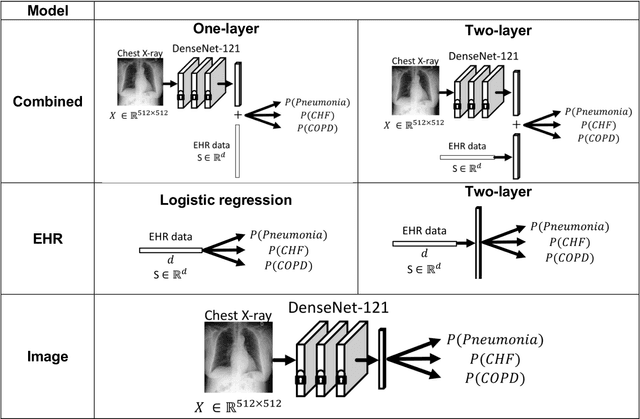Combining chest X-rays and EHR data using machine learning to diagnose acute respiratory failure
Paper and Code
Aug 27, 2021



When patients develop acute respiratory failure, accurately identifying the underlying etiology is essential for determining the best treatment, but it can be challenging to differentiate between common diagnoses in clinical practice. Machine learning models could improve medical diagnosis by augmenting clinical decision making and play a role in the diagnostic evaluation of patients with acute respiratory failure. While machine learning models have been developed to identify common findings on chest radiographs (e.g. pneumonia), augmenting these approaches by also analyzing clinically relevant data from the electronic health record (EHR) could aid in the diagnosis of acute respiratory failure. Machine learning models were trained to predict the cause of acute respiratory failure (pneumonia, heart failure, and/or COPD) using chest radiographs and EHR data from patients within an internal cohort using diagnoses based on physician chart review. Models were also tested on patients in an external cohort using discharge diagnosis codes. A model combining chest radiographs and EHR data outperformed models based on each modality alone for pneumonia and COPD. For pneumonia, the combined model AUROC was 0.79 (0.78-0.79), image model AUROC was 0.73 (0.72-0.75), and EHR model AUROC was 0.73 (0.70-0.76); for COPD, combined: 0.89 (0.83-0.91), image: 0.85 (0.77-0.89), and EHR: 0.80 (0.76-0.84); for heart failure, combined: 0.80 (0.77-0.84), image: 0.77 (0.71-0.81), and EHR: 0.80 (0.75-0.82). In the external cohort, performance was consistent for heart failure and COPD, but declined slightly for pneumonia. Overall, machine learning models combing chest radiographs and EHR data can accurately differentiate between common causes of acute respiratory failure. Further work is needed to determine whether these models could aid clinicians in the diagnosis of acute respiratory failure in clinical settings.
 Add to Chrome
Add to Chrome Add to Firefox
Add to Firefox Add to Edge
Add to Edge